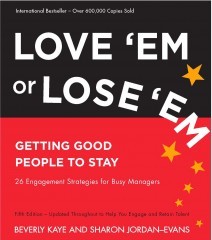 Guest Post by Beverly Kaye and Sharon Jordan-Evans
Guest Post by Beverly Kaye and Sharon Jordan-Evans
Celebrating the release of the 5th edition of the bestseller Love ‘Em or Lose ‘Em: Getting Good People to Stay by Beverly Kaye and Sharon Jordan-Evans, which provides twenty-six strategies to keep talented employees happy and productive. In addition to updating and revising all information for the fifth edition, the authors have included more international stories and statistics.
Beverly Kaye is the Founder of Career Systems International. Sharon Jordan-Evans is the President of the Jordan Evans Group. Their guest post illuminates one of the 26 strategies described in their book.
All great performers are interested in learning, and the opportunity to learn can be a greater incentive than a promotion or pay raise. Learning opportunities through job enrichment can alleviate boredom, motivate top performers and can even re-recruit disengaged employees.
It Can Happen to Anyone
Did your own “job EKG” ever go flat? Did the feeling of challenge change to a feeling of routine? Did you start to wonder what else there was? Did you start to look around?
Unfortunately, your most valued employees are the most likely to suffer this sense of job discontent. By definition, they are savvy, creative, self-propelled, and energetic. They need stimulating work, opportunities for personal challenge and growth, and a contributing stake in the organizational action.
What Would You Like to Learn?
Job enrichment can provide employees with the growth, challenge, and renewal they desire without having to leave their job. It involves changing what they do or how they do it – which inevitably involves learning. In fact, it begins with asking, “What would you like to learn?”
Sergey had been in his current job for almost two years and was starting to think about looking for a new job because he was getting bored and didn’t see any opportunities for promotion in the company. But that changed when his boss asked him what he wanted to learn next. When he said, “I’d like to develop negotiating skills,” she replied, “Let’s go for it.” Here are the steps they followed:
Step 1. Conscious Observation. Sergey’s boss selected an expert for Sergey to observe—someone who was exceptionally skilled at negotiating. After the observation, Sergey and his boss discussed what Sergey noticed, learned, would mirror or do differently.
Step 2. Selected Participation. Sergey’s boss gave him the chance to take a well-defined but limited role in a negotiation (preparing the opening remarks with a vendor). The goal was to give Sergey an opportunity to get his feet wet and experience success. Following the meeting, Sergey and his boss discussed what worked and where there might be room for improvement.
Step 3. Key Responsibility. Sergey’s boss gave him primary responsibility for a project that required negotiation skills. Sergey completed the entire negotiation with the vendor and was both visible and accountable for the outcome. His boss was present, of course, but would have stepped in only if Sergey requested his support.
One year later, Sergey still has the same job, but he continues to deepening his skills, take on more challenging assignments and is thrilled.
In short, creating learning opportunities and allowing employees to sculpt their jobs helps them turn the job they have into a job they love.













Great Jesse!
It`s so clear for me that we need to find the better way to learn something that we like. I believe that is so important that leaders can discover how they can help his employees to find what make then happy. Thanks for sharing with us your learning. Best regards from Brazil
Rodrigo
Thanks Rodrigo — best wishes helping employees enrich their jobs!
Cheers,
Sharon
I agree. Quite often these days, people tell me they are leaving their job because there’s nothing more for them to learn, especially the younger millennial workers. Creating learning opportunities on the job is such an easy and effective way to keep workers happy. Thanks for sharing your thoughts, Rodrigo.
Because of your guest column here by Beverly and Sharon, Jesse, I am getting the book. Their views buttress what The Progress Principal co-author Teresa Amabile advocates, about the vital need to have employees feel their work is meaningful and that they see at least some small signs of progress most days.
As well, as an advocate of encouraging and enabling employees to adopt a mutuality-mind set I believe it is any organization’s self-interest to support employees in becoming able, authentic and articulate ambassadors of the company brand, and thus their own. Here are some of the reasons, and they complement your valuable book, Full Steam Ahead http://www.forbes.com/sites/kareanderson/2013/03/24/make-your-company-top-of-mind-and-your-employees-proud/2/
Hi Kare — thanks for your comments. We’re singin’ off the same page for sure. I love the “mutuality-mindset” concept and believe it is core to engaging and retaining top talent. I see it this way — as long as the company is getting what it wants and needs from me and I’m getting what I want and need from them — let’s keep working/playing together!
I am delighted to keep on learning from you Sharon and Jesse
Thanks, Kare. That means a lot coming from you.
Thanks so much Kare!
How wonderful to see my brilliant colleagues on the same page: Beverly, Kare, Jesse, and Sharon. Do you think we can change the world?
No doubt! 🙂
Hi Eileen — of course we can! 🙂